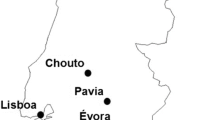Abstract
Unlike other natural disasters, drought events evolve slowly in time and their impacts generally span a long period of time. Such features do make possible a more effective drought mitigation of the most adverse effects, provided a timely monitoring of an incoming drought is available.
Among the several proposed drought monitoring indices, the Standardized Precipitation Index (SPI) has found widespread application for describing and comparing droughts among different time periods and regions with different climatic conditions. However, limited efforts have been made to analyze the role of the SPI for drought forecasting.
The aim of the paper is to provide two methodologies for the seasonal forecasting of SPI, under the hypothesis of uncorrelated and normally distributed monthly precipitation aggregated at various time scales k. In the first methodology, the auto-covariance matrix of SPI values is analytically derived, as a function of the statistics of the underlying monthly precipitation process, in order to compute the transition probabilities from a current drought condition to another in the future. The proposed analytical approach appears particularly valuable from a practical stand point in light of the difficulties of applying a frequency approach due to the limited number of transitions generally observed even on relatively long SPI records. Also, an analysis of the applicability of a Markov chain model has revealed the inadequacy of such an approach, since it leads to significant errors in the transition probability as shown in the paper. In the second methodology, SPI forecasts at a generic time horizon M are analytically determined, in terms of conditional expectation, as a function of past values of monthly precipitation. Forecasting accuracy is estimated through an expression of the Mean Square Error, which allows one to derive confidence intervals of prediction. Validation of the derived expressions is carried out by comparing theoretical forecasts and observed SPI values by means of a moving window technique. Results seem to confirm the reliability of the proposed methodologies, which therefore can find useful application within a drought monitoring system.
Similar content being viewed by others
References
Bonaccorso B, Bordi I, Cancelliere A, Rossi G, Sutera A (2003) Spatial variability of drought: an analysis of SPI in Sicily. Water Resour Manag 17:273–296
Bordi I, Fraedrich K, Petitta M, Sutera A (2005) Methods for predicting drought occurrences. In: Proc. of the 6th international conference of the European water resources association Menton, France, pp 7–10 September 2005
Bremaud P (1999) Markov chains, Gibbs fields, Montecarlo simulation and queues, Springer, The Netherlands
Brockwell PJ, Davis RA (1996) Introduction to time series and forecasting Springer-Verlag ed., New York, pp 1–422
Cancelliere A, Di Mauro G, Bonaccorso B, Rossi G (2005) Stochastic forecasting of standardized precipitation index. Proc. of XXXI IAHR Congress “Water engineering for the future: choice and challenges”. Seoul, Korea, 11–16 September 2005, pp 3252–3260
Cancelliere A, Rossi G, Ancarani A (1996) Use of Palmer Index as drought indicator in Mediterranean regions. Proc. IAHR Congress “From flood to drought”. Sun City, South Africa, August 5–7, 1996, S4.12–1–25
Guttman NB, (1998) Comparing the Palmer drought severity index and the standardized precipitation Index. J Amer Water Res Ass 34(1):113–121
Guttman NB (1999) Accepting the standardized precipitation index: a calculating algorithm. J Amer Water Res Ass 35(2):311–323
Hayes MJ, Svoboda M, Wilhite DA, Vanyarkho O (1999) Monitoring the 1996 drought using the SPI. Bull Amer Meteor Soc 80:429–438
Heim RR (2000) Drought indices: a review. In: DA Wilhite (ed) Drought: a global assessment. Routledge, London and New York
Karl T, Quinlan F, Ezell DS (1986) Drought termination and amelioration: its climatological probability. J Climate Appl Meteor 26:1198–1209
Keyantash J, Dracup JA (2002) The quantification of drought: an evaluation of drought indices. Bull Amer Meteor Soc 83(8):1167–1180
Klemes V (1986) Operational testing of hydrological simulation models. Hydrol Sci J 31(1):13–24
Lohani VK, Loganathan GV, Mostaghimi S (1998) Long-term analysis and short-term forecasting of dry spells by Palmer drought severity index. Nord Hydrol 29(1):21–40
McKee TB, Doesken NJ, Kleist J (1993) The relationship of drought frequency and duration to time scales. In: Proc. 8th conference on applied climatology. Anaheim, California, pp 179–184
Mood AM, Graybill FA, Boes E (1974) Introduction to the theory of statistics. McGraw-Hill, New York
Rossi G, Cancelliere A (2002) Early warning of drought: development of a drought bullettin for Sicily. Proc. 2nd international conference “New trends in water and environmental engineering for safety and life: eco-compatible solutions for aquatic environments”. Capri, Italy, June 24–28, 2002, pp 1–12
Rossi G (2003) Requisites for a drought watch system. In: G. Rossi et~al. (ed), tools for drought mitigation in Mediterranean regions. Kluwer Academic Publishing, Dordrecht, pp 147–157
Schervish MJ (1984) Algorithm AS 195. Multivariate normal probabilities with error bound. Applied Statistics 33(1):81–94
Wilhite DA, Hayes MJ, Svoboda MD (2000) Drought monitoring and assessment: status and trends in the United States. In: Vogt JV, Somma F (eds) Drought and drought mitigation in Europe. Kluwer Academic Publishers, pp 149–160
Author information
Authors and Affiliations
Corresponding author
Rights and permissions
About this article
Cite this article
Cancelliere, A., Mauro, G.D., Bonaccorso, B. et al. Drought forecasting using the Standardized Precipitation Index. Water Resour Manage 21, 801–819 (2007). https://doi.org/10.1007/s11269-006-9062-y
Received:
Accepted:
Published:
Issue Date:
DOI: https://doi.org/10.1007/s11269-006-9062-y




